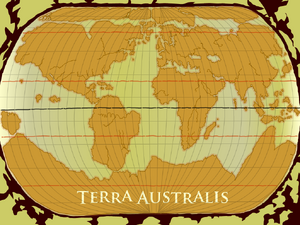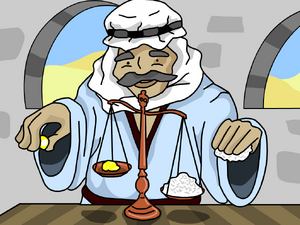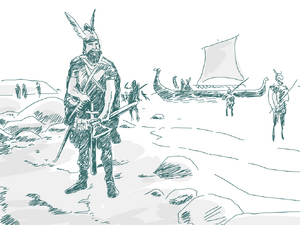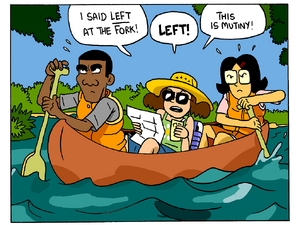| Henry Hudson | |||
|---|---|---|---|
 | |||
| Airdate | May 13, 2015 | ||
| Curriculum | Social Studies | ||
Henry Hudson is a BrainPOP Social Studies video that aired on May 13, 2015.
Summary[]
The video opens with Tim and Moby playing a video game called "Quest for the Northwest Passage".
After talking about Henry Hudson, the video ends with Moby exhibiting a glass of ice water with a sign saying "Don't drink!" because Tim said that there is more water than land named after Henry Hudson.
Appearances[]
Transcript[]
Quiz[]
FYI[]
Way Back When[]

Before the Age of Exploration literally put North and South America on the map, maps tended to be... well, a little strange. Often, unexplored areas had drawings or legends on them warning people about the monsters, ferocious beasts, and sea serpents that lurked there.
Roman maps often included the phrase Hic Sunt Leones, which means “here there are lions.” The medieval German map known as the Tabula Peutingeriana labels a spot where “dog-headed creatures are born.” The 15th-century Borgia map notes that Asia contains “men having large horns four feet long,” as well as “serpents of such magnitude that they can eat an ox whole.” And the 13th-century Ebstorf Map places dragons in Africa.
In addition to these weird notes, a completely made-up continent called Terra Australis (Latin for “southern lands”) appeared on European maps between the 15th and 18th centuries. The idea behind Terra Australis came from the writings of ancient philosophers Aristotle and Ptolemy, who thought that there should be a large southern continent to “counterbalance” Europe and Asia.
Terra Australis usually appeared as a gigantic version of Antarctica. In the late 1770s, British explorer James Cook was commissioned by the Royal Society to find this continent. Instead, his expedition to the Southern Ocean disproved its existence.
Did You Know[]

New York City was one of the most important cities in the Thirteen Colonies. But before it became a crown jewel of the British Empire, it was a crown jewel of the Dutch Republic!
Originally named New Amsterdam, New York City started off as a colonial town right outside Fort Amsterdam on Manhattan Island (pictured) in the New Netherland territory. It was founded in 1625 as a permanent settlement for the Dutch West India Company; its location on the southern tip of Manhattan was perfect for defending the company’s fur trade operations in New York Harbor and the Hudson River.
In 1626, the Dutch purchased Manhattan from the American Indians already living on the island. According to legend, Peter Minuit, the director-general of New Netherland, exchanged only $24 worth of goods for the entire island, making it the greatest real estate deal in history!
New Amsterdam continued to grow, becoming the largest colony in the New Netherland province. But in 1664, during a war between England and the Dutch Republic, it fell under English control. It was renamed New York in honor of King James II (who also held the title of Duke of York), and New York City was officially incorporated the following year, becoming the oldest incorporated city in the United States! The Dutch recaptured the city briefly in 1673 with a fleet of 21 ships and renamed it New Orange—but a peace treaty signed a year later handed it back to the English for good.
Trivia[]

- The Silk Road introduced a number of remarkable Chinese inventions to the West, including silk, paper, gunpowder, and the compass.
- The term “Silk Road” was coined in 1870 by German geographer Ferdinand von Richthofen. His nephew, Manfred von Richtofen, better known as the Red Baron, was the most successful fighter pilot of World War I.
- Some of the spices traded along the Silk Routes—including cinnamon, nutmeg, and saffron—were worth more than their weight in gold!
- Central Asia's Taklamakan Desert earned such a deadly reputation among Silk Road travelers, “Taklamakan” is widely believed to mean, “Go in and you will not come out.” In reality, it’s probably derived from an Arabic phrase meaning “abandoned place.”
- The Silk Road trade introduced peaches and rhubarb to Europe. It brought dates, pistachios, and grapes to China.
- Under the Trans-Asia Railway Network Agreement, 17 Asian nations are now attempting to link up existing railroads to form an unbroken line between the Mediterranean and coastal China. Some refer to the project as the Iron Silk Road.
- Many historians believe that along with silk and spices, Silk Road traders may have accidentally brought the Black Death to Europe. The disease killed up to 60 percent of the European population in the 1300s.
Etc.[]

Contrary to popular belief, Christopher Columbus wasn’t the first European to visit the Americas. That honor belongs to a crew of Vikings, or Scandinavian sailors, who visited the eastern coast of Canada in the 10th and 11th centuries.
Their stories are written in the Sagas of Icelanders, prose histories that document the exploits of different Viking families. According to these sagas, a Viking named Erik the Red established a colony in Greenland around 985. Soon, settlers began moving there from Iceland.
On one trip over, a merchant got blown off course and sighted land to the west. The merchant told Leif Eriksson, son of Erik the Red, what he’d seen. Ten years later, Leif bought the merchant’s ship, rounded up a crew of 35 guys, and set sail for North America.
Leif explored territories he called “Land of the flat stones” (possibly Baffin Island) and “Land of the forests” (probably part of present-day Labrador). He also established a colony at a place he called Vinland, which either meant “Land of the meadows” or “Land of grapevines.”
Unfortunately for Leif, the Vinland colony did not survive. The Vikings wound up fighting with native people, one of whom even killed Leif’s brother Thorvald. The Vikings left after a just few years.
In 1960, the remains of a Viking settlement were discovered in L’Anse aux Meadows, at the northern tip of Newfoundland. It might be Vinland itself, or it might be a smaller camp. Either way, it provides definitive evidence that Europeans visited the Americas before Columbus.
In Depth[]

Henry Hudson's third voyage was arguably his most successful. He became the first explorer to navigate the river that now bears his name, paving the way for new settlements in the area now known as New York. There was just one problem: he was sailing for the Dutch, not the English.
Not surprisingly, Hudson didn't get a hero's welcome when he returned to England. The crown seized his ship and accused him of treason for sailing under a foreign nation's flag. By order of King James I, Hudson was placed under house arrest. He feared for his life as royal soldiers watched over his every move.
Help soon arrived. Sir Thomas Smythe, a wealthy merchant who sought to profit from the Northwest Passage, visited Hudson and offered him a ticket to freedom. As long as Hudson agreed to sail for England, Smythe would finance his next voyage. Hudson leapt at the opportunity.
Smythe arranged for Hudson to meet Henry Frederick, the Prince of Wales. The 16-year-old was an excellent student, and he was fascinated by geography. He was also one of the few people who wasn't afraid of his father, James I.
Hudson told the young prince about his travels and his determination to find the Northwest Passage in the name of England. The prince agreed to speak to the king. Soon after, Hudson was pardoned! But the smooth sailing was short-lived, as Hudson immediately set sail on the voyage that would prove to be his last.
Around The World[]

Age of Exploration navigators searching for a Northwest Passage never stood a chance. Even in the summer, the Arctic has historically been choked with too much ice to be passable. But global warming is likely to change that pattern for the first time in over one million years.
Arctic ice reaches its lowest point around September. Then it rebounds, as melted seawater refreezes over the winter. But rising temperatures are melting ice faster than ever before. Many scientists predict completely ice-free summers in the Arctic Ocean by about 2050.
That's bad news for the environment, but a potential opportunity for shipping companies. In 2007, the Northwest Passage thawed for the first time in recorded history. For a few months each year, merchant vessels can now navigate the shorter trade route to Asia that Hudson only dreamed about.
Stretching across the top of North America from Canada to Alaska, the route shaves 2,500 miles off the voyage from Europe to Asia. That translates to tens of thousands of dollars in fuel savings for a modern cargo ship.
But there's more than one way to cross the Arctic. The Northeast Passage connects the Atlantic and Pacific Oceans by following the northern coast of Russia. Compared to a trip through the Suez Canal, the voyage from Germany to China along the Northeast Passage saves 3,700 miles. It also lets ships avoid of pirate-infested waters near Africa and Indonesia.
Despite these rewards, shipping along the Northwest and Northeast Passages has yet to take off. Only four cargo ships used the Northeast Passage in 2010. And while that number increased to 71 in 2013, it's still far lower than the 17,000 ships that pass through the Suez Canal every year.
Sailing the Arctic is still dangerous. While much of the ice has melted, the remaining chunks are big enough to tear holes in even the sturdiest cargo ships. Icebreaker ships can pave the way, but their cost eats into the fuel savings of using the Arctic routes.
Experts don't expect the Arctic to become a shipping superhighway anytime soon. But in a few decades, it's a distinct possibility. By then, the world could have bigger problems to deal with.
FYI Comic[]

